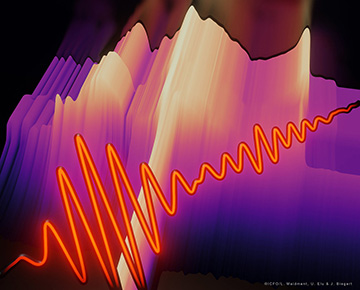
Artist’s impression of the spectrum of a mid-infrared pulse broadening in the background with the electric field of the generated pulse. [Image: ICFO/L.Maidment, U. Elu and J. Biegert]
Some optical experiments demand everything: a huge range of frequencies, temporal coherence and high brightness. Tabletop lasers and large synchrotron facilities can fulfill some of those demands individually, but not all.
Now, researchers from several European institutes have developed a compact light source that provides simultaneous emission across seven frequency octaves from terahertz to ultraviolet (Nat. Photonics, doi: 10.1038/s41566-020-00735-1). The bench-top light source gives off up to five orders of magnitude more brightness than synchrotron sources and could become an important tool for hyperspectral spectroscopy and imaging in medical and environmental studies.
Three key technologies
According to team leader and OSA Fellow Jens Biegert of ICFO, Spain, the bench-top system would not have worked without all three of its main components: an ultrafast source of mid-infrared light, a specially designed photonic-crystal fiber and a nonlinear crystal that could handle the high photon flux of the system.
In the experimental setup, the light originated with ultrashort mid-infrared laser pulses feeding into an optical parametric chirped-pulse amplifier. From there, the radiation passes through a 20-cm-long antiresonant-reflection photonic-crystal fiber developed by a group including OSA Fellow Philip St. J. Russell, Max-Planck Institute for the Science of Light and Friedrich-Alexander University, Germany. The fiber, with an internal diameter of 92 μm, sat inside an argon-filled chamber; varying the gas pressure between 20 bar and 35 bar changed the soliton and dispersive-wave generation of the system. A pressure of 25 bar produced the most efficient dispersive-wave generation.
Next in the light path came a 2.6-mm-thick crystal of the compound BaGa2GeSe6, which stimulated an effect called intra-pulse difference frequency generation—spreading out the light spectrum from 340 nm to 40,000 nm. This compound beat out two other types of nonlinear crystal for the best combined figure of merit.
“The biggest challenge was the very large and unknown parameter space which we had to investigate to achieve breakthrough brilliance, spectral bandwidth and phase stability, all combined,” Biegert says.
Energy and environmental applications
The researchers hope that their work could be applied to experiments with condensed-phase and molecular-phase matter, ranging from inter-band transitions and charge transfer excitons in the ultraviolet region to secondary structures of proteins in the infrared to terahertz regions. Biegert says he and his colleagues can test only a few in their own laboratories.
“For us, we will use this source for our research on attosecond electron diffraction to study chemical dynamics, and we will use it to study attosecond dynamics in topological insulators or light-induced states in quantum materials,” Biegert adds. “All of these topics are related to energy efficiency and standing environmental issues.”
Besides Biegert and Russell, the team included scientists from Kuban State University, Russia; Max Born Institute for Nonlinear Optics and Ultrafast Spectroscopy, Germany; and ICREA – Catalan Institution for Research and Advanced Studies, Spain.
